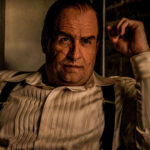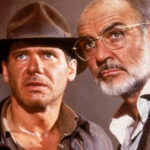

Released in 1994, “Interview with the Vampire: The Vampire Chronicles” became a landmark in the vampire film genre, captivating audiences with its innovative approach and dark atmosphere. Directed by Neil Jordan and based on Anne Rice’s best-seller, the film features a star-studded cast, including Tom Cruise, Brad Pitt, and Kirsten Dunst, whose intense performances bring the complex plot of immortality and desire to life.
The narrative, told from the perspective of a vampire revealing his story to a reporter, explores deep themes such as mortality, isolation, and the search for meaning. Besides its fascinating plot, the film stands out for its unique visual style and the gothic atmosphere that permeates every scene.
In this text, we will delve into some intriguing facts about the production and behind-the-scenes of this cinematic classic, revealing secrets that make “Interview with the Vampire: The Vampire Chronicles” an unforgettable work.
1 – BASED ON A BOOK
Anne Rice’s book was first published in 1976, and Paramount Pictures acquired the rights as early as April of that year, even before the official publication. However, the script faced several setbacks and was eventually sold to the distributor Lorimar, before being acquired by Warner Bros. The project remained shelved until director Neil Jordan, after the tremendous success of “The Crying Game” (1992), was invited to adapt it.
Jordan initially showed interest in the script but became truly captivated by the story after reading Anne Rice’s book. He made adjustments to the script to better align with his vision. If the film had been released in the late 1970s, it’s possible that John Travolta could have played the role of Lestat!
2 – PREJUDICE AGAINST VAMPIRE FILMS
Despite the rights being acquired in 1976, the film took quite some time to be produced. At that time, there was a certain prejudice against vampire films due to several unsuccessful, low-budget productions that had associated the genre with B-movies. When the studio learned about Coppola’s project, it decided to give the genre another chance but waited to evaluate the performance of “Bram Stoker’s Dracula” at the box office in 1992.
With the success and growing popularity of vampires at the time, the studio finally gave the green light for Neil Jordan to move forward with the production.
3 – THE BOOK AUTHOR DIDN’T WANT TOM CRUISE TO PLAY LESTAT
When Anne Rice created the character Lestat in her book, she was inspired by the image of actor Rutger Hauer. For the film adaptation, Rice wanted French actor Alain Delon for the role of Louis and British actor Julian Sands for Lestat. However, the project faced delays until, in 1993, the studio finally approved the production. The choice of Tom Cruise, a major star, did not please Anne Rice, who openly criticized the decision.
However, Cruise prepared intensely for the role: he read all the books about Lestat, learned to play the piano and fencing, and spent time in Paris and New Orleans to capture the book’s atmosphere. After watching his performance at the premiere, Rice changed her mind and praised Cruise’s work, even calling the actor to apologize. Cruise was paid $10 million for the role, plus a share of the profits—a very favorable outcome.
4 – ACTOR DIED BEFORE FILMING STARTED
Initially, the role of journalist Daniel Molloy, who interviews Louis, was to be played by River Phoenix, Joaquin Phoenix’s brother. However, River passed away a few weeks before filming began. Christian Slater then took on the role of the journalist, receiving a salary of $250,000, which he donated to charity in honor of Phoenix. At the end of the film’s credits, there is a special dedication to the actor.
5 – KIRSTEN DUNST ALMOST MISSED THE ROLE
The young actress who played Claudia, the vampire girl created by Lestat to keep Louis by his side, impressed audiences with her performance. She was discovered by a talent scout, who later became her agent. During the audition for the role, the agent was listening from behind the door and, upon seeing her leave, asked her to come back in.
He then told the producers, “She can do more than this”, and requested that she audition again. The result was positive, and she got the part. Interestingly, the kiss she gave Brad Pitt in the balcony scene was her first kiss, and the actress revealed that she did not enjoy the experience at all.
6 – THE CHARACTER CLAUDIA WAS BASED ON THE AUTHOR’S DAUGHTER
Anne Rice was extremely pleased with Kirsten Dunst’s performance in the film. Claudia is a complex character, a woman in a child’s body, unable to fend for herself. In the book, Claudia is only 5 years old, which made it challenging to portray such a young child with mature characteristics in the film. The character was inspired by Rice’s daughter, Michelle, who passed away at the age of 5 in 1972 due to leukemia.
Rice once commented:
“I had a prophetic dream in which my daughter died because of something bad in her blood. It was a terrible nightmare.”
7 – BRAD PITT WANTED TO QUIT THE FILM
At one point, Brad Pitt was exhausted with the film’s shoot. He received the script only two weeks before filming began and spent six months playing a melancholic and sorrowful character. Pitt dealt with uncomfortable contact lenses, spent long hours on a dark set, and suffered from the cold on the streets of London and Paris.
Tired, he called veteran producer David Geffen and said, “I’m worn out, I can’t take it anymore. How much would it cost for me to leave the production?” David replied, “40 million dollars.” With that answer, Brad Pitt decided to continue.
8 – HOMOEROTIC CONTENT
Aware of the homophobia present in both society and the studio, Anne Rice had to tone down the homoerotic aspects of the book when adapting the script. At one point, she even rewrote Louis as a woman, and David Geffen considered singer and actress Cher for the role.
Cher even composed a song for the film, called “Lovers Forever,” in collaboration with Shirley Eikhard. However, the track was rejected by the producers and was only released on Cher’s 2013 album, Closer to the Truth.
9 – HEAVY MAKEUP
The actors needed to spend three hours in makeup before filming, and the process was quite uncomfortable. Tom, Brad, Kirsten, and the other actors playing vampires had to lie upside down for half an hour several times so that blood would flow to their heads. This allowed the makeup artists to draw veins on the actors’ faces and create the translucent, thin, and eerie effect.
Michèle Burke, the head of the film’s makeup department, is a two-time Oscar winner, one for “Quest for Fire” (1981) and another for “Bram Stoker’s Dracula” (1992).
10 – A HAUNTED FARM
The farm where Louis lives in the film is a real property called Destrehan Plantation, located west of New Orleans. However, footage from Oak Alley Plantation, situated along the Mississippi River in Vacherie, Louisiana, was also used. According to local stories, the latter plantation is haunted.
The legend says that the former owner, Josephine Stewart, or her daughter, Louise, lost one of her legs due to gangrene. One of these women is said to have returned as a ghost, and some crew members reported seeing a spectral figure with long hair wandering the property.
“Interview with the Vampire: The Vampire Chronicles” continues to be a landmark in the vampire film genre, offering a unique and fascinating view of the dark and complex world of vampires. From its troubled production to the impressive performances of its star-studded cast, the film exemplifies how the passion and commitment of those involved can overcome significant challenges. The curiosities surrounding the film—ranging from Kirsten Dunst’s inspiring performance to the complexities of vampire makeup—reveal the care and dedication invested in every aspect of the production.
Anne Rice, despite her initial reservations, eventually recognized the value of the adaptation, and the film’s enduring influence is a testament to the talent and hard work of everyone involved. With a combination of an engaging story and impressive technical execution, Interview with the Vampire remains an eternal classic in cinema.








